 |
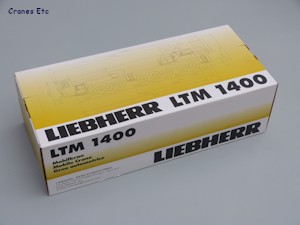 |
| The box.
|
 |
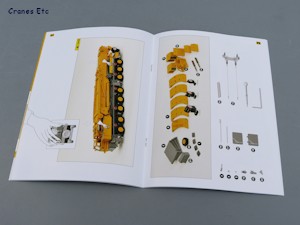 |
| Excellent
brochure includes a parts list. |
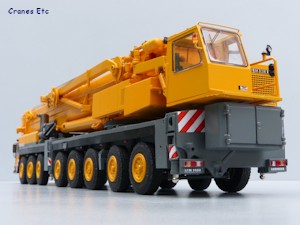 |
| Proportions
look great. |
 |
| Tiny tie-on
point under the cab. |
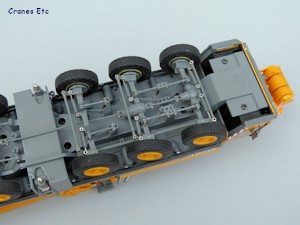 |
| Detailed axles. |
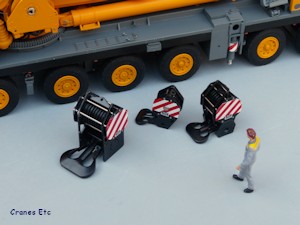 |
| Three different
hooks. |
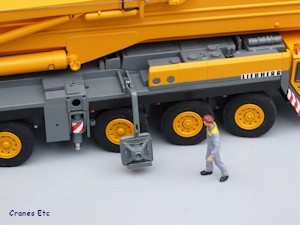 |
| Pads being
lowered. |
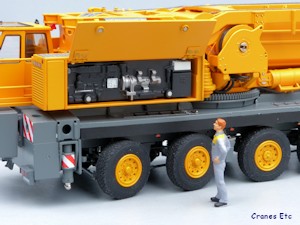 |
| Opening flap on
the crane. |
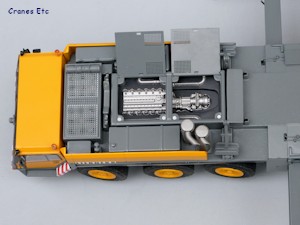 |
| Opening engine
covers. |
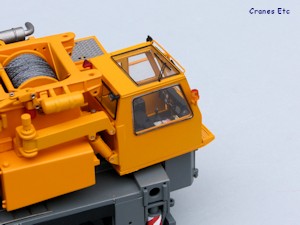 |
| Terrific detail
inside the cab.
|
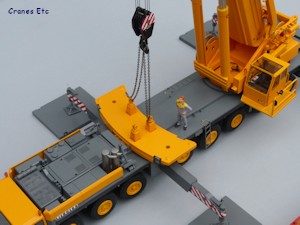 |
| Setting the
counterweight. |
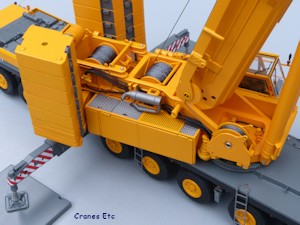 |
| Excellent
detail.
|
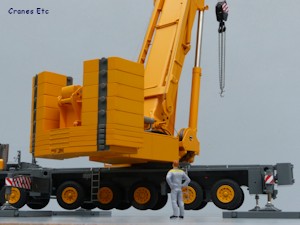 |
| Full
counterweight. |
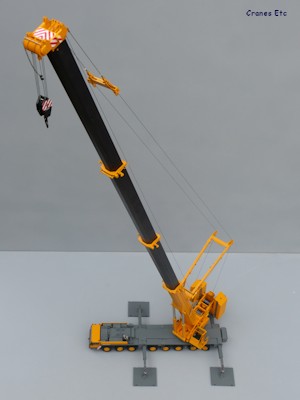 |
| Boom sections
at 100% extension. |
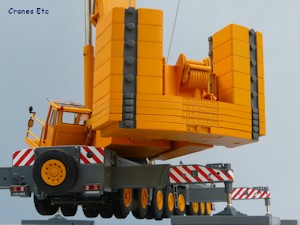 |
| Spare wheel
fitted at the back. |
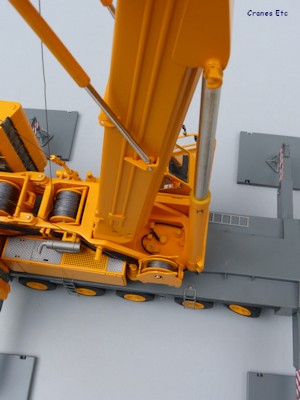 |
| Excellent boom
and hydraulics detail. |
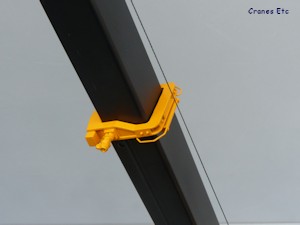 |
High detail at
each boom section collar.
|
|
 Comment on this model. Comment on this model.
This model of the Liebherr LTM 1400 represents a
historic crane from the 1990's and some aspects of its
design are dated compared to more modern cranes. It had
a nominal lifting capacity of 400 tonnes and could lift to 50m on
the four-section telescopic boom.
Packaging
The model comes in a heavy outer cardboard carton which protects a
Liebherr branded
box in slightly different colouring to modern models. Inside that is a
pair of expanded polystyrene trays
which contain the model. A very nice touch is that
the two trays are locked together with plastic clips at
each end and this is much better than having the trays
being taped together. Many parts are wrapped in soft
paper.
The model is very detailed and delicate and has to be handled with care
as any pressure on small parts whilst lifting it will inevitably
damage them. The instructions recognise this and give
clear advice on how to handle the model.
There was one defect on the review model. An
opening engine cover was detached, and YCC quickly
dispatched a tiny part to make a good repair.
A high quality brochure is included which has a reprint
of the original machine specifications. The instructions
for the model are top quality and show almost every
aspect of the assembly and features, with the only
exception being the reeving of the hoist line over the
lowest boom section and guying system.
Also included is a high quality commemorative key ring.
Assembly is straightforward, and only care is required
to handle some of the very small parts and pins.
In particular tiny pins are fine in a posed model but
will work loose under handling and, if dropped, will be
hard to find.
Detail
The crane carrier is very highly detailed. Underneath,
the chassis has good detail with the main transmission
and suspension elements modelled. The wheels are excellent
with detailed hubs (which are different on the driven axles)
and tyres which have Michelin and the tyre details in the
sidewalls.
The driving cab is of a very high standard and the
interior detail is really good. The wipers and mirrors
are finely crafted, and the lights and number plates look
convincing.
Behind the cab the detailing of the engine area is
really good too, with fans visible under the grilles and
opening hatches reveal a detailed metal engine which is
modelled in relief rather than as a separate part with
space around it.
The exhaust stacks look very convincing too.
There are thin rubber skirts above the wheels, very thin
metal access ladders and small metal wheel chocks fit
into special holders. At the rear the light
clusters are very good. Two options exist at the
rear. Either a spare tyre can be fitted or a tool
box.
The modelling of the outriggers is excellent.
Special holders for the pads are replicated, and the
beams are metal with high quality graphics. Even
the locking bolts for the beams are provided. The
pistons have a smooth external appearance so look
authentic and the metal pads are finely crafted.
Heavy spreader plates with lifting points are included.
The crane body structure rests on a convincing looking
heavy toothed turntable.
The operator's cab is excellent with fine quality grab
rails and lights and the interior detail is top class
with highlighted instrument clusters.
Detail around the body continues the very high standard
with an excellent exhaust system being a standout, and
under opening covers there are detailed components.
Hydraulic hoses run to the various rams and motors.
The counterweight consists of a number of separate plates
with very sharp casting details. The secondary
winch assembly includes a set of hydraulic hoses and
useable lifting eyes.
The twin hydraulic cylinders for the boom are all metal
components. As an example of attention to detail tiny
magnetic cover plates are provided to cover the grub
screws that lock the extension.
The four stage telescopic boom has a great
profile with the
external locking pins of the real crane modelled, and there are
working roller bars throughout. At the boom head
there are free-rolling metal pulleys and plenty of tie-off points including a minute one for the hoist cut-out
chain.
The guying arrangement is also finely modelled and
only in one area is there a small issue with the scaling
as the tension rope rubs on part of the guying system frame
rather than running cleanly from pulley to pulley.
Three different sizes of hook are supplied. These
are all metal and top quality and include excellent
graphics.
Features
The carrier has fully sprung suspension on each axle and
each steerable axle steers enabling any of the available
modes of the real crane to be replicated.
The cab doors open widely and a nice touch on these and
other openers is that small embedded magnets are used to
secure them in the closed position. However the
compromise is that they are silver and visible when
open.
Two hatches open on top of the engine.
Wheel chocks can be stored or removed, and four ladders
can be rotated and deployed.
At the rear a spare tyre can be carried, or a toolbox
fitted which has opening doors.
On each side there is a tiny opening flap which gives
access to the outrigger beam controls. The loader
arms
for the pads work and they can be used to lower the pads
to the ground for deployment.
The two-stage outrigger beams extend smoothly and can be
locked in place in the 50% and 100% locking positions.
The pads are slightly magnetic so they usually stick on
if the model is moved, and the pistons are lowered by
unscrewing.
The crane rotates extremely smoothly, so much so that it
will rotate if the crane is not set level.
The operator's cab can be rotated out from transport
position, and also tilts. The cab door
slides open and shut. Two cab windscreens are
provided, one for the closed transport position and
another for the open operating position.
There is an opening cover on each side of the crane
body.
The counterweight can be configured like the real crane
and can be stowed on the carrier deck to simulate
self-erection.
The boom lifting cylinders are perfectly smooth in operation
and they are locked at any extension by tightening a
discrete grub screw at the top of each cylinder jacket
using the special tool supplied.
The telescopic boom extensions pull out very smoothly
and the spring loaded locking pins work really well.
They are able to lock each section at the 50%, 92% and
100% positions of the real crane. The boom also has working rollers to
guide the winch line.
The guying system folds open and the winch has a positive
brake so it can be tensioned up quite tight. The
guying arrangement can also be detached if not
required.
The winch drums are operated using a special
tool and if required it can powered by an electric
screwdriver to raise and lower the hook. The brakes are
spring loaded with positive action so the
winches will hold a load.
The hook blocks have rotating hooks and working spring-loaded
safety latches.
Quality
The model is very well made and has a very high metal
content. A large number of parts has been used and
some of them are absolutely tiny in order to faithfully
represent detail. As a consequence the model is
delicate and needs to be handled with respect.
The paintwork and graphics are excellent.
Price
As expected this top quality model commands a high
price, but it is good value nonetheless and it is
more likely than many to hold value in the longer term.
Overall
To get straight to the point, this model sets a new
high standard for a mobile crane model, and it seems as
if every detail and every aspect from the packaging to
the smallest part of the model has been carefully
considered. If you are looking for the most
authentic crane model available at the time of the
review, look no further.
Footnotes
The model first appeared as a prototype at the Nuremberg
Toy Fair in February 2014. Shipments began in
September. Initially it was also produced in Thomen and
Sarens liveries, and others followed.
This model was awarded Model of the Year for 2014 in the
Cranes Etc Review of the Year.
A luffing fly jib
extension kit appeared at the end of 2015.
|
|
 |
|
|
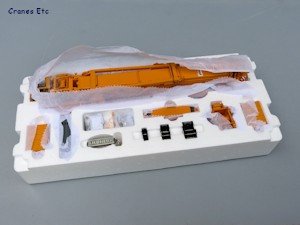 |
| Tray includes a
commemorative key ring. |
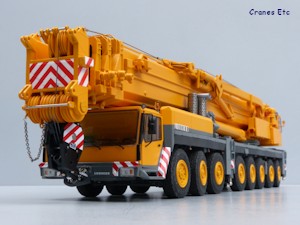 |
| Super
realistic. |
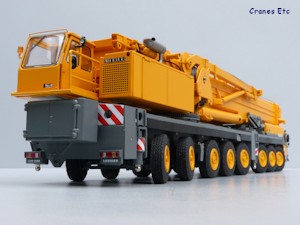 |
| Moderate
steering angles. |
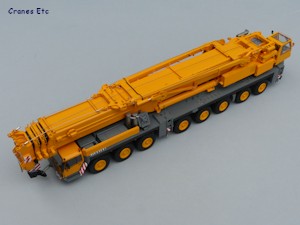 |
| On the road. |
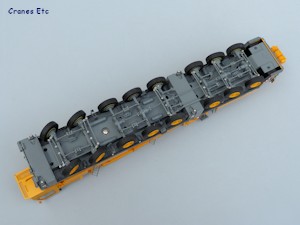 |
| Overall view of
the underneath.
|
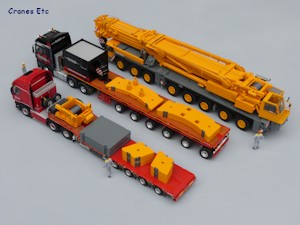 |
| Makes a great
transport display. |
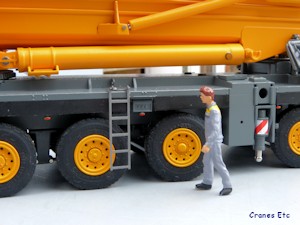 |
| Access ladder
lowered and a tiny console for outrigger operation has
an opening flap. |
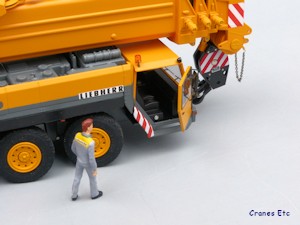 |
| Opening cab
door. Silver head is the magnet.
|
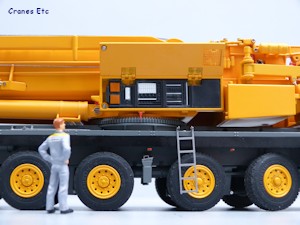 |
| Another opening
panel cover. |
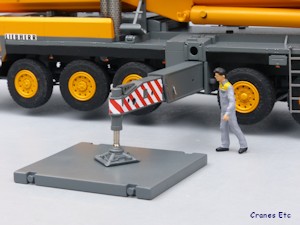 |
| Outrigger beam
with locking bolt installed. |
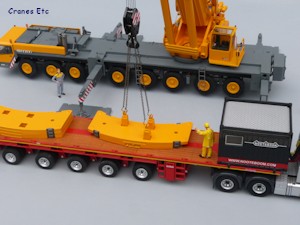 |
| Are the Cranes
Etc team slinging the load correctly?. |
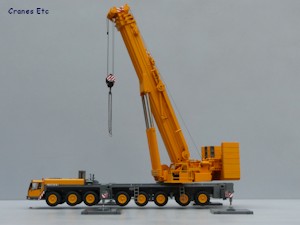 |
| Set up ready. |
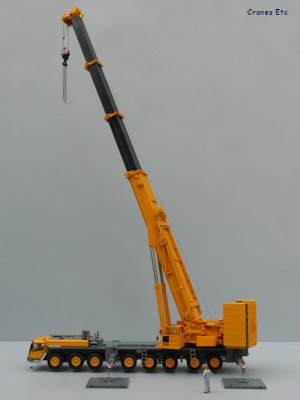 |
| Boom sections
at 50% extension. |
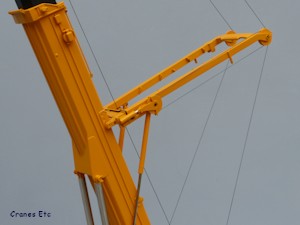 |
| Guying system
opened up. |
|
|
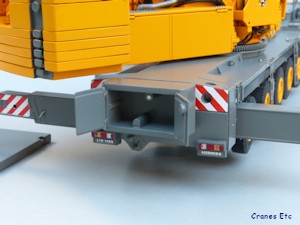 |
| Opening tool
box. |
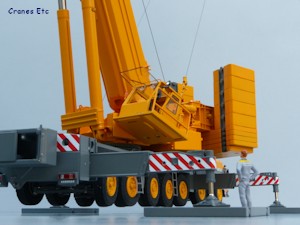 |
| Top notch
model. |
|

